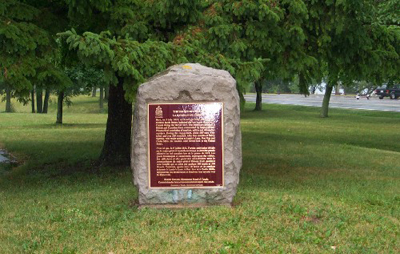Battle of Chippawa National Historic Site of Canada
Chippawa, Ontario

General view
(© Parks Canada Agency / Agence Parcs Canada, 2005.)
Address :
Niagara River Parkway, Chippawa, Chippawa, Ontario
Recognition Statute:
Historic Sites and Monuments Act (R.S.C., 1985, c. H-4)
Designation Date:
1921-05-21
Dates:
-
1814 to 1814
(Significant)
Event, Person, Organization:
-
War of 1812
(Event)
-
Brigadier-General Winfield Scott
(Person)
-
Jacob Brown
(Person)
-
Major-General Phineas Riall
(Person)
Other Name(s):
-
Battle of Chippawa
(Designation Name)
Research Report Number:
1992-023, 2009-CED-SDC-005
Plaque(s)
Existing plaque: Battle of Chippawa Park Niagara River Parkway, Chippawa, Ontario
Here, on 5 July 1814, an American army under Major-General Jacob Brown launched the last major invasion of Canada during the War of 1812. The Americans defeated a British and Canadian force commanded by Major-General Phineas Riall consisting of regulars, militia and Aboriginal warriors. During the engagement, about 200 men were killed and over 500 wounded. After four months of heavy fighting, with major action at Lundy's Lane, Fort Erie and Cooks Mills, the invaders were forced back to the United States.
Description of Historic Place
The Battle of Chippawa National Historic Site of Canada is located south of the town of Chippawa, Ontario, on the west side of the Niagara River Parkway. It is the site of a battle that took place during the War of 1812 as a result of the last major American invasion of Canada in 1814. There are no visible remains of this battle, and the site was recognized with a Historic Sites and Monuments Board of Canada cairn and plaque in 1923. The site comprises a wooded northern section, an abandoned agricultural field, and a southern portion of mixed fields and woods. Official recognition includes the 121 hectares of Chippawa Battlefield Park, extending beyond the park’s limits to the high water marks of the Niagara River and Usshers Creek.
Heritage Value
The Battle of Chippawa was designated a national historic site of Canada in 1921 because: it was the first major encounter between British and American forces in Upper Canada in 1814.
The Battle of Chippawa took place on July 5, 1814, as part of the last major American invasion of Canada of the War of 1812. Under the command of Jacob Brown, Brigadier-General Winfield Scott left Fort Erie on July 4 with a force of 1300 American troops. They set up camp several hundred yards away from the Chippawa River, and waited for further reinforcements. Brown arrived with 2000 more troops around midnight.
On the morning of July 5, Major-General Phineas Riall sent a small contingent of troops to attack the Americans with sniper fire and to gain information on their numbers. When the troops returned to General Riall, they reported to him that the Americans appeared to be militiamen, not the highly trained regular troops, as they were wearing grey coats and not uniforms. Acting upon this false assumption, General Riall attacked with his force of 1400 regulars, 70 cavalrymen, and 300 Aboriginal allies. When he sent his troops through the woods for cover, he encountered 56 of Brown’s regulars who had also been placed in the woods. A battle ensued and the British were able to push the Americans back towards their camp.
As both sides prepared for battle and marched on Street’s Field, General Riall realized that the Americans calmly marching towards him from their own camp were not militiamen, as he had originally thought, but were in fact highly trained regulars. Faced with skilled troops more numerous than his own, General Riall was forced to retreat across the Chippawa River.
Sources: Historic Sites and Monuments Board of Canada, Minutes, 1921, 1966, 1992, March 2009.
Character-Defining Elements
Key elements contributing to the heritage value of this site include: the location, near Chippawa, Ontario; the setting, incorporating a wooded northern section, an abandoned agricultural field, and a southern portion of mixed fields and woods; the wooded section of the landscape and its relation to the battle, as well as the Historic Sites and Monuments Board of Canada cairn and plaque designating the area; the integrity of any surviving or as yet unidentified archaeological remains, which may be found within the site in their original placement; the viewscapes of Chippawa River to the west.